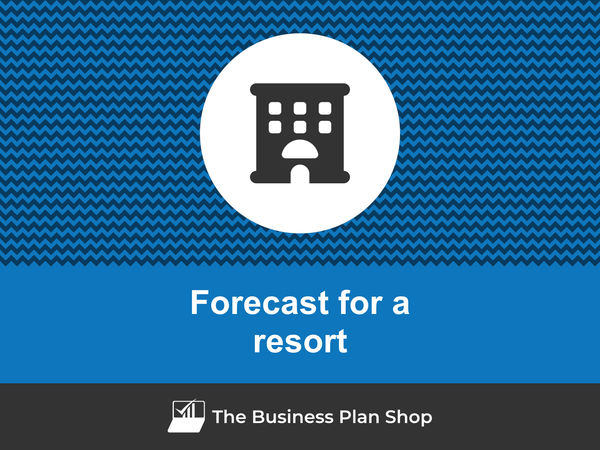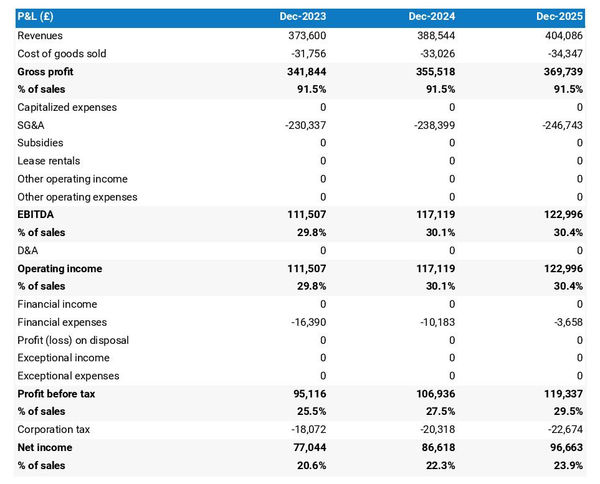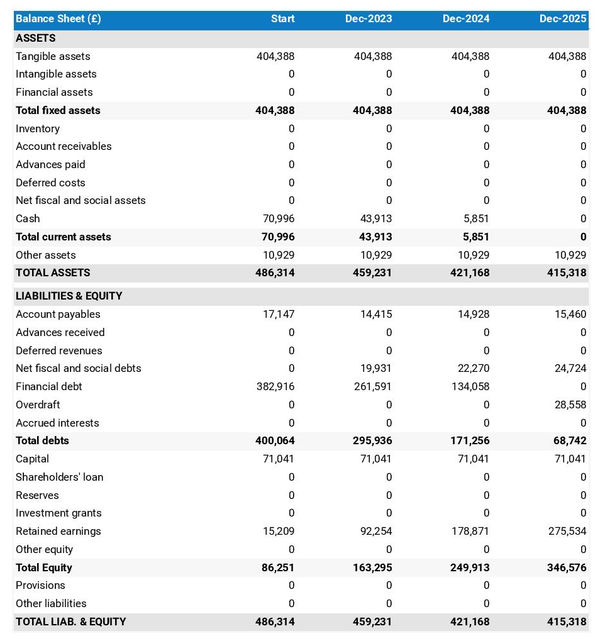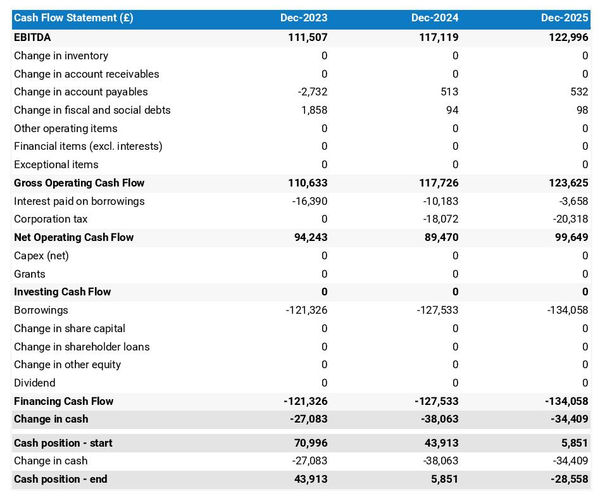How to create a financial forecast for a resort?

If you are serious about keeping visibility on your future cash flows, then you need to build and maintain a financial forecast for your resort.
Putting together a resort financial forecast may sound complex, but don’t worry, with the right tool, it’s easier than it looks, and The Business Plan Shop is here to guide you.
In this practical guide, we'll cover everything you need to know about building financial projections for your resort.
We will start by looking at why they are key, what information is needed, what a forecast looks like once completed, and what solutions you can use to create yours.
Let's dive in!
Why create and maintain a financial forecast for a resort?
Creating and maintaining an up-to-date financial forecast is the only way to steer the development of your resort and ensure that it can be financially viable in the years to come.
A financial plan for a resort enables you to look at your business in detail - from income to operating costs and investments - to evaluate its expected profitability and future cash flows.
This gives you the visibility needed to plan future investments and expansion with confidence.
And, when your trading environment gets tougher, having an up to date resort forecast enables you to detect potential upcoming financing shortfalls in advance, enabling you to make adjustments or secure financing before you run out of cash.
It’s also important to remember that your resort's financial forecast will be essential when looking for financing. You can be 100% certain that banks and investors will ask to see your numbers, so make sure they’re set out accurately and attractively.
Need a solid financial forecast?
The Business Plan Shop does the maths for you. Simply enter your revenues, costs and investments. Click save and our online tool builds a three-way forecast for you instantly.

What information is used as input to build a resort financial forecast?
A resort's financial forecast is only as good as the inputs used to build it.
If you are creating (or updating) the forecast of an existing resort, then you mostly need your accounting information, key historical operating non-financial data, and your team’s input on what to expect for the coming years.
If you are building financial projections for a resort startup, you will need to have done your research and have a clear picture of your competitive environment and go-to-market strategy so that you can forecast sales accurately.
For a new venture, you will also need a precise list of the resources needed to keep the resort running on a day-to-day basis and a list of the equipment and expenditures required to start the business (more on that later).
Let's now take a closer look at the elements that make up your resort's financial forecast.
The sales forecast for a resort
From experience, it is usually best to start creating your resort financial forecast by your sales forecast.
To create an accurate sales forecast for your resort, you will have to rely on the data collected in your market research, or if you're running an existing resort, the historical data of the business, to estimate two key variables:
- The average price
- The number of monthly transactions
To get there, you will need to consider the following factors:
- Seasonal Demand: As a resort owner, you know that the demand for your services varies throughout the year. Factors such as school holidays, weather conditions, and special events can greatly affect the number of guests who visit your resort and the prices you can charge.
- Competition: The presence of other resorts in your area can also impact your average price and monthly transactions. If there are many similar resorts nearby, you may need to adjust your prices or offer special deals to stay competitive and attract guests.
- Economic Conditions: Changes in the economy, such as a recession or a boom, can have a significant impact on your business. During tough economic times, guests may be more likely to opt for cheaper accommodations, while in a thriving economy, they may be willing to pay more for luxury experiences.
- Customer Preferences: The preferences of your target audience can also affect your sales forecast. For example, if your resort primarily caters to families, you may see an increase in bookings during school holidays or summer months. Alternatively, if your target audience is young professionals, you may see higher demand during weekends or holidays.
- Infrastructure and Facilities: Your resort's infrastructure and facilities can also impact your average price and number of transactions. If you invest in upgrades and new amenities, you may be able to charge higher prices and attract more guests. On the other hand, if your facilities are outdated, you may need to offer lower prices to remain competitive.
Once you have an idea of what your future sales will look like, it will be time to work on your overhead budget. Let’s see what this entails.
Need inspiration for your business plan?
The Business Plan Shop has dozens of business plan templates that you can use to get a clear idea of what a complete business plan looks like.

The operating expenses for a resort
The next step is to estimate the expenses needed to run your resort on a day-to-day basis.
These will vary based on the level of sales expected, and the location and size of your business.
But your resort's operating expenses should include the following items at a minimum:
- Staff Costs: This includes salaries, wages, and benefits for all resort employees, including front desk staff, housekeeping, food and beverage staff, and maintenance workers.
- Accountancy Fees: You will need to hire an accountant to manage the financial aspects of your resort, including bookkeeping, payroll, and tax preparation.
- Insurance Costs: To protect your resort from potential risks and liabilities, you will need to pay for various insurance policies, such as property insurance, liability insurance, and workers' compensation insurance.
- Software Licences: In order to efficiently manage your resort's operations, you will need to invest in software licences for various systems, such as reservation management, point of sale, and accounting software.
- Banking Fees: You will incur fees for various banking services, such as processing credit card payments, wire transfers, and foreign currency exchange.
- Marketing Expenses: To attract and retain guests, you will need to invest in marketing efforts, such as advertising, promotions, and website development.
- Utilities: You will need to pay for utilities, such as electricity, water, and gas, to keep your resort running smoothly.
- Maintenance and Repairs: Regular maintenance and repairs are necessary to keep your resort in good condition. This includes costs for equipment maintenance, landscaping, and building repairs.
- Supplies: You will need to purchase various supplies, such as linens, toiletries, and cleaning products, to keep your resort stocked and maintained.
- Food and Beverage Costs: If your resort offers dining options, you will need to cover the costs of food and beverages, as well as staffing for the kitchen and restaurant.
- Housekeeping Expenses: To keep your resort rooms clean and well-maintained, you will need to pay for housekeeping services and supplies.
- Guest Services: You may need to hire additional staff or invest in technology to provide exceptional guest services, such as concierge services and guest amenities.
- Taxes and Permits: You will need to pay various taxes and obtain necessary permits to operate your resort legally.
- Training and Development: In order to provide high-quality service, you may need to invest in training and development programs for your staff.
- Security: To ensure the safety and security of your guests and employees, you may need to invest in security measures, such as cameras, alarms, and security personnel.
This list is, of course, not exhaustive, and you'll have to adapt it according to your precise business model and size. A small resort might not have the same level of expenditure as a larger one, for example.
What investments are needed to start or grow a resort?
Creating and expanding a resort also requires investments which you need to factor into your financial forecast.
Capital expenditures and initial working capital items for a resort could include elements such as:
- Property Improvements: This includes any renovations or upgrades to existing buildings or structures on the resort property. Examples could include adding new rooms or amenities, updating the landscaping, or renovating common areas such as pools or restaurants.
- Equipment and Machinery: Resorts require a lot of specialized equipment to keep operations running smoothly. This could include things like kitchen appliances, laundry machines, or maintenance equipment. As these items age and need to be replaced, they should be included in the expenditure forecast.
- Furniture and Fixtures: As with any hospitality business, the furniture and fixtures in a resort play a big role in creating a comfortable and inviting atmosphere for guests. This could include items like beds, couches, tables, and chairs. Over time, these items will need to be replaced or refreshed, so it's important to budget for them in the forecast.
- Technology and IT Infrastructure: In today's digital age, it's essential for resorts to have up-to-date technology and IT infrastructure to provide a seamless experience for guests. This could include investments in new software, hardware, or communication systems. As technology continues to advance, it's important to budget for these upgrades in the expenditure forecast.
- New Construction: If the resort is planning to expand or build new structures, this should also be included in the expenditure forecast. This could include new buildings, recreation areas, or other amenities that will enhance the guest experience and attract new visitors to the resort.
Again, this list is not exhaustive and will need to be adjusted according to the circumstances of your resort.
Need a convincing business plan?
The Business Plan Shop makes it easy to create a financial forecast to assess the potential profitability of your projects, and write a business plan that’ll wow investors.

The financing plan of your resort
The next step in the creation of your financial forecast for your resort is to think about how you might finance your business.
You will have to assess how much capital will come from shareholders (equity) and how much can be secured through banks.
Bank loans will have to be modelled so that you can separate the interest expenses from the repayments of principal, and include all this data in your forecast.
Issuing share capital and obtaining a bank loan are two of the most common ways that entrepreneurs finance their businesses.
What tables compose the financial plan for a resort?
Now let's have a look at the main output tables of your resort's financial forecast.
The projected profit & loss statement
The projected profit & loss shows how profitable your resort is likely to be in the years to come.

For your resort to be financially viable, your projected P&L should ideally show:
- Sales growing above inflation (the higher the better)
- Profit margins which are stable or expanding (the higher the better)
- A net profit at the end of each financial year (the higher the better)
This is for established resorts, there is some leniency for startups which will have numbers that will look a bit different than existing businesses.
The projected balance sheet
Your resort's projected balance sheet provides a snapshot of your business’s financial position at year-end.
It is composed of three types of elements: assets, liabilities and equity:
- Assets: represent what the business possesses including cash, equipment, and accounts receivable (money owed by clients).
- Liabilities: represent funds advanced to the business by lenders and other creditors. They include accounts payable (money owed to suppliers), taxes payable and loans from banks and financial institutions.
- Equity: is the combination of what has been invested by the business owners and the cumulative profits and losses generated by the business to date (which are called retained earnings). Equity is a proxy for the value of the owner's stake in the business.

The cash flow projection
The cash flow forecast of your resort will show how much cash the business is expected to generate or consume over the next three to five years.

There are multiple ways of presenting a cash flow forecast but from experience, it is better to organise it by nature in order to clearly show these elements:
- Operating cash flow: how much cash is generated by the resort's operations
- Investing cash flow: what is the business investing to expand or maintain its equipment
- Financing cash flow: is the business raising additional funds or repaying financiers (debt repayment, dividends)
Your cash flow forecast is the most important element of your overall financial projection and that’s where you should focus your attention to ensure that your resort is adequately funded.
Note: if you are preparing a financial forecast in order to try to secure funding, you will need to include both a yearly and monthly cash flow forecast in your resort's financial plan.
Need a solid financial forecast?
The Business Plan Shop does the maths for you. Simply enter your revenues, costs and investments. Click save and our online tool builds a three-way forecast for you instantly.

Which tool should you use to create your resort's financial forecast?
Creating your resort's financial forecast may sound fairly daunting, but the good news is that there are several ways to go about it.
Using online financial forecasting software to build your resort's projections
The modern and easiest way is to use an online financial forecasting tool such as the one we offer at The Business Plan Shop.
There are several advantages to using specialised software:
- You can easily create your financial forecast by letting the software take care of the financial calculations for you without errors
- You have access to complete financial forecast templates
- You get a complete financial forecast ready to be sent to your bank or investors
- You can easily track your actual financial performance against your financial forecast, and recalibrate your forecast as the year goes by
- You can create scenarios to stress test your forecast's main assumptions
- You can easily update your forecast as time goes by to maintain visibility on future cash flows
- You have a friendly support team on standby to assist you when you are stuck
- It’s cost-efficient and much cheaper than using an accountant or consultant (see below)
If you are interested in this type of solution, you can try our projection software for free by signing up here.
Hiring a financial consultant or chartered accountant
Hiring a consultant or chartered accountant is also an efficient way to get a professional resort financial projection.
As you can imagine, this solution is much more expensive than using software. From experience, the creation of a simple financial forecast over three years (including a balance sheet, income statement, and cash flow statement) is likely to start around £700 or $1,000 excluding taxes.
The indicative estimate above, is for a small business, and a forecast done as a one-off. Using a financial consultant or accountant to track your actuals vs. forecast and to keep your financial forecast up to date on a monthly or quarterly basis will naturally cost a lot more.
If you choose this solution, make sure your service provider has first-hand experience in your industry, so that they may challenge your assumptions and offer insights (as opposed to just taking your figures at face value to create the forecast’s financial statements).
Why not use a spreadsheet such as Excel or Google Sheets to build your resort's financial forecast?
Creating an accurate and error-free resort financial forecast with a spreadsheet is very technical and requires a deep knowledge of accounting and an understanding of financial modelling.
Very few business owners are financially savvy enough to be able to build a forecast themselves on Excel without making mistakes.
Lenders and investors know this, which is why forecasts created on Excel by the business owner are often frowned upon.
Having numbers one can trust is key when it comes to financial forecasting and to that end using software is much safer.
Using financial forecasting software is also faster than using a spreadsheet, and, with the rise of artificial intelligence, software is also becoming smarter at helping us analyse the numbers to make smarter decisions.
Finally, like everything with spreadsheets, tracking actuals vs. forecasts and keeping your projections up to date as the year progresses is manual, tedious, and error-prone. Whereas financial projection software like The Business Plan Shop is built for this.
Need a convincing business plan?
The Business Plan Shop makes it easy to create a financial forecast to assess the potential profitability of your projects, and write a business plan that’ll wow investors.

Use our financial projection templates for inspiration
The Business Plan Shop has dozens of financial forecast templates available.
Our examples contain a complete business plan with a financial forecast and a written presentation of the company, the team, the strategy, and the medium-term objectives.
Whether you are just starting out or already have your own resort, looking at our financial forecast template is a good way to:
- Understand what a complete business plan should look like
- Understand how you should model financial items for your resort

Takeaways
- A financial forecast shows expected growth, profitability, and cash generation metrics for your resort.
- Tracking actuals vs. forecast and having an up-to-date financial forecast is key to maintaining visibility on your future cash flows.
- Using financial forecasting software is the modern way of creating and maintaining financial projections.
We hope that this guide helped you gain a clearer perspective on the steps needed to create the financial forecast for a resort. Don't hesitate to contact us if you have any questions!
Need inspiration for your business plan?
The Business Plan Shop has dozens of business plan templates that you can use to get a clear idea of what a complete business plan looks like.

Also on The Business Plan Shop
Know someone who runs a resort? Share our business guide with them!





